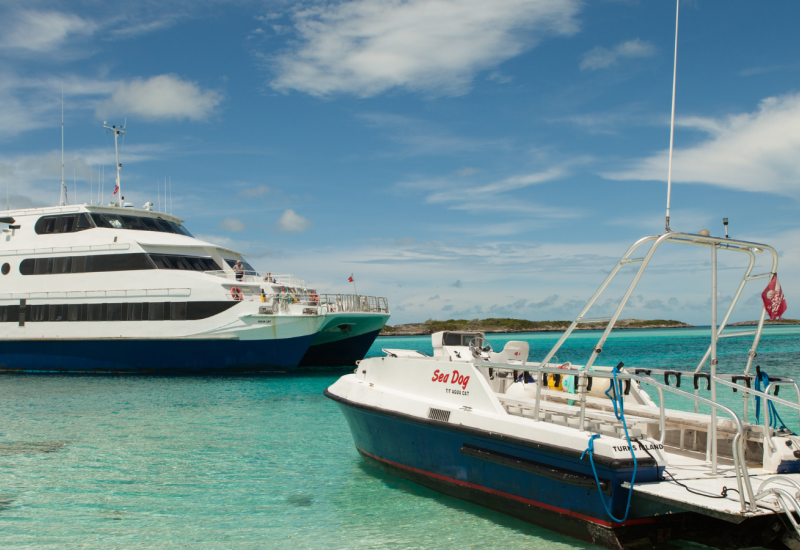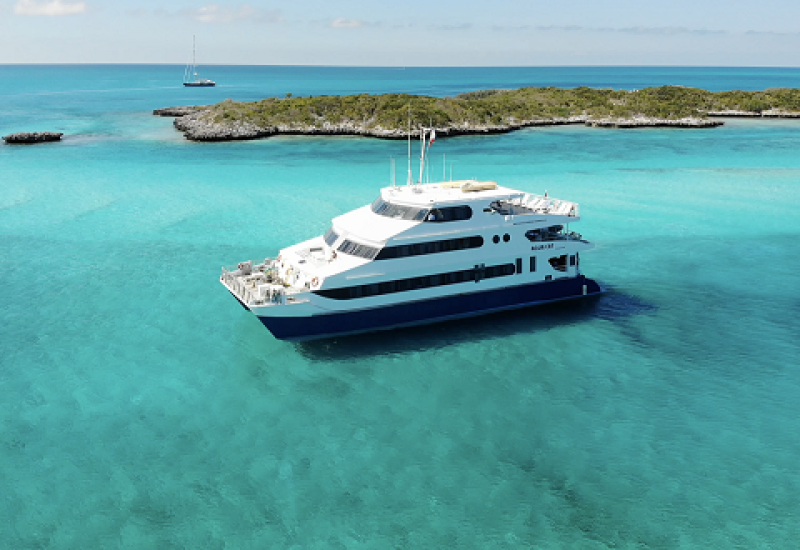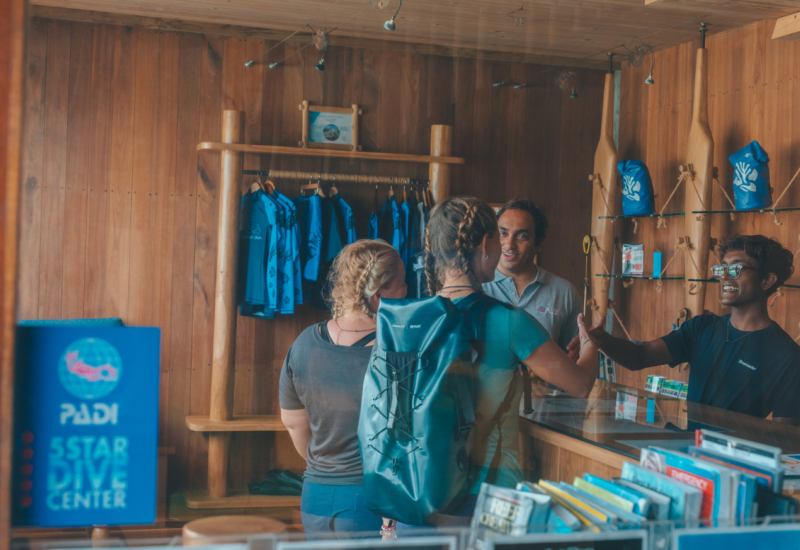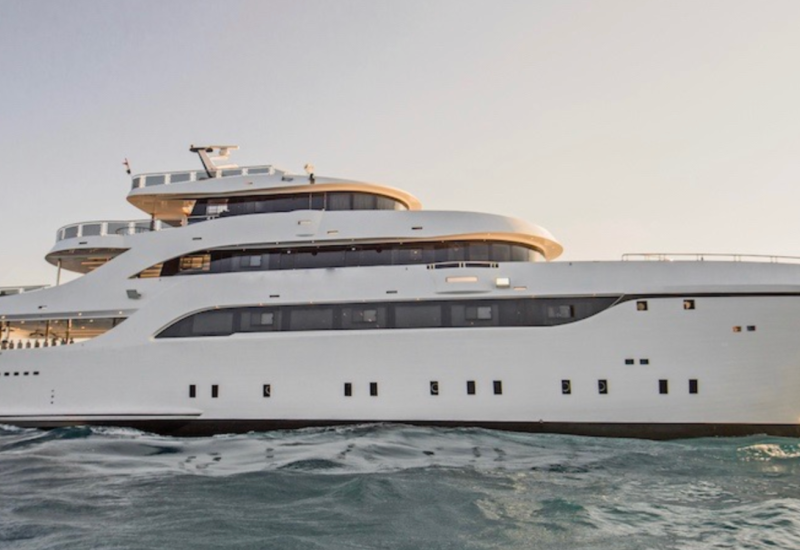Liveaboard Diving in Pulau Weh Aboard the Thailand Aggressor
Every time I mentioned to dive colleagues that I was headed to Pulau Weh, I got the exact same response — "Lucky you — I've been to Palau many times!" they would exclaim. The names might be similar, but that one vowel makes the difference between landing in Micronesia or Indonesia, where I was headed.
Pulau Weh (Weh Island) is a tiny island of the northern tip of Sumatra, surrounded by the Indian Ocean and the Andaman Sea. Weh in Acehnese, the language spoken by the people of Aceh Province, means to move or go away. But I understand why the community didn’t abandon this beautiful scenery and prolific sea life after the 2004 tsunami.
Ten years ago, one of the most devastating events imaginable occurred. Entire islands were obliterated by a powerful tsunami with waves nearly 50 feet high, carrying the power of several Hiroshima-size atomic bombs. Banda Aceh, where we boarded our ferry to Weh Island, was destroyed, and more than 150,000 people were killed. Today it’s a vibrant, revitalized city with an impressive museum honoring those lost in the disaster. I came to dive, but what I gained was a deeper understanding of the strength of the human spirit. And local reefs have proved just as strong as the people of Aceh Province.
Since the tsunami, the underwater habitat has recovered and become a hot diving destination, especially for vessels like Thailand Aggressor. Aggressor is the first liveaboard to operate out of Pulau Weh in cooperation with local dive operators. Its itinerary has something for everyone, from viewing unusual creatures in the shallows to riding strong currents through forests of gorgonian sea fans. The yacht visits more than 22 dive sites, with new ones being discovered frequently.
The biodiversity here aligns with many Indo-Pacifc destinations. Canyons and cuts through underwater volcanic structures create scenes that make any diver hunger for more. Giant sea fans and sponges cling to rocky formations that resemble ancient and ornate architecture. Seemingly desolate shallows harbor fascinating creatures — some I’ve never seen before. In one location, bubbles from volcanic vents warm the body in a spa-like environment. With its exceptional crew, Thailand Aggressor certainly knows how to pamper.
After our dive at a site called the Underwater Volcano — a natural Jacuzzi where warm water bubbles up — many of us continued the treatment on the upper deck with a relaxing Thai massage.
Experiencing Thai cuisine was key for me; Thailand Aggressor’s master chef pulled out all the stops, including the best hot chilies for afcionados of Asian cuisine. Other diners echoed the same sentiment: Make mine Thai, please!
PULAU WEH DIVE GUIDE
The first full day of diving got our blood pumping. The Canyon is the perfect spot for adrenaline junkies, where strong currents will take you soaring through amazing underwater landscapes. At nearly 100 feet, the canyon’s grooves are filled with giant sea fans — nowhere else in the Indo-Pacific have I seen coral structures like these, a sentiment echoed by my fellow divers. “Never seen the likes of this before,” exclaimed Peter Tongue, who has dived with Aggressor Fleet all over the world.
No wonder there are so many schools of anthias, as well as an overwhelming assortment of other tropical species. It was spectacular to see major-league tuna and snapper. The red-toothed triggerfish and fusiliers were so thick at times that they blocked our view of the reef — until a tuna makes a hit. BANG, like a gunshot, and the schools scatter, bringing the wall back into the scene.
Late-afternoon and night dives at a favorite site called Limbo Gapang offered a chance to see as many diferent creatures as possible. On one dive I found a grumpy old stonefish about the size of a football, and the creepy inimicus, with its clawlike appendages for walking on the ocean floor. The zebra moray — shy and difficult to photograph — has been on my bucket list for some 20 years; the opportunity to watch this animal tucked into a reef with a completely different species of eel as a companion was thrilling.
Skipping along the bottom was another hunter of the dark: the starry night octopus. It was mating season, and we counted numerous pairs of octopuses unfazed by voyeurs in wetsuits; they just kept right on copulating. “I’ve never seen so many cephalopods, arms entangled in romance,” said diver Robin Faulkner, who seemed to spend the whole dive in one spot, hanging eye to eye with the octopuses.
The pilings of Gapang Jetty shelter innumerable sea creatures. Schools of white collar butterflyfish hang near each post and move quickly to the next one if approached too closely. I spent a big chunk of time next to one of the wooden pilings that supported an anemone filled with clownfish. It was an excellent vantage point to peer down into the rest of the support structure and take in the whole scene.
Tokong is an outcropping of a rocky island that has two sites for incredible dive experiences. It is also one of the most popular dive sites in the area, for good reason. This rock drops down to around 72 feet from the surface, before sloping to around 130 feet. A huge variety of fish gather at this site, with bigger predators skirting the edges of the rock. On one of our dives, we were blessed with a pack of 30 monster-size tuna that came in close. The price we paid for this viewing spectacle was current; if not for the many areas where you can tuck behind the reef, it would be difficult and sometimes impossible to dive this location, one of the things that makes it so special. The sloping area of Tokong is carpeted with a garden of massive gorgonians secured on rock formations that give it the nickname “the moray condo.” Giant and honeycomb eels occupy just about every crevice and overhang.
For divers who want to explore the newest of destinations, more Pulau Weh gems like these await, with new sites added to the itinerary all the time.

Michele WestmorlandMore Pulau Weh gems like these await with new diving sites added to the itinerary all the time. Look for day octopuses — the largest octupus found in the western Pacific — in rubbly reef terrain.
Every time I mentioned to dive colleagues that I was headed to Pulau Weh, I got the exact same response — "Lucky you — I've been to Palau many times!" they would exclaim. The names might be similar, but that one vowel makes the difference between landing in Micronesia or Indonesia, where I was headed.
Pulau Weh (Weh Island) is a tiny island of the northern tip of Sumatra, surrounded by the Indian Ocean and the Andaman Sea. Weh in Acehnese, the language spoken by the people of Aceh Province, means to move or go away. But I understand why the community didn’t abandon this beautiful scenery and prolific sea life after the 2004 tsunami.

Michele WestmorlandThailand Aggressor gives you the same confidence in service as any of the fleet vessels. TA has been updated and remains a comfortable boat, with big picture windows in the main-deck staterooms.
Ten years ago, one of the most devastating events imaginable occurred. Entire islands were obliterated by a powerful tsunami with waves nearly 50 feet high, carrying the power of several Hiroshima-size atomic bombs. Banda Aceh, where we boarded our ferry to Weh Island, was destroyed, and more than 150,000 people were killed. Today it’s a vibrant, revitalized city with an impressive museum honoring those lost in the disaster. I came to dive, but what I gained was a deeper understanding of the strength of the human spirit. And local reefs have proved just as strong as the people of Aceh Province.
Since the tsunami, the underwater habitat has recovered and become a hot diving destination, especially for vessels like Thailand Aggressor. Aggressor is the first liveaboard to operate out of Pulau Weh in cooperation with local dive operators. Its itinerary has something for everyone, from viewing unusual creatures in the shallows to riding strong currents through forests of gorgonian sea fans. The yacht visits more than 22 dive sites, with new ones being discovered frequently.

Michele WestmorlandEnormous sea fans in the Canyon can be found diving in the Pulau Weh.
The biodiversity here aligns with many Indo-Pacifc destinations. Canyons and cuts through underwater volcanic structures create scenes that make any diver hunger for more. Giant sea fans and sponges cling to rocky formations that resemble ancient and ornate architecture. Seemingly desolate shallows harbor fascinating creatures — some I’ve never seen before. In one location, bubbles from volcanic vents warm the body in a spa-like environment. With its exceptional crew, Thailand Aggressor certainly knows how to pamper.
After our dive at a site called the Underwater Volcano — a natural Jacuzzi where warm water bubbles up — many of us continued the treatment on the upper deck with a relaxing Thai massage.
Experiencing Thai cuisine was key for me; Thailand Aggressor’s master chef pulled out all the stops, including the best hot chilies for afcionados of Asian cuisine. Other diners echoed the same sentiment: Make mine Thai, please!

Michele WestmorlandLet the Thai Aggressor show you the way to Pulau Weh, Indonesia's latest dive hot spot.
PULAU WEH DIVE GUIDE
The first full day of diving got our blood pumping. The Canyon is the perfect spot for adrenaline junkies, where strong currents will take you soaring through amazing underwater landscapes. At nearly 100 feet, the canyon’s grooves are filled with giant sea fans — nowhere else in the Indo-Pacific have I seen coral structures like these, a sentiment echoed by my fellow divers. “Never seen the likes of this before,” exclaimed Peter Tongue, who has dived with Aggressor Fleet all over the world.
No wonder there are so many schools of anthias, as well as an overwhelming assortment of other tropical species. It was spectacular to see major-league tuna and snapper. The red-toothed triggerfish and fusiliers were so thick at times that they blocked our view of the reef — until a tuna makes a hit. BANG, like a gunshot, and the schools scatter, bringing the wall back into the scene.
Late-afternoon and night dives at a favorite site called Limbo Gapang offered a chance to see as many diferent creatures as possible. On one dive I found a grumpy old stonefish about the size of a football, and the creepy inimicus, with its clawlike appendages for walking on the ocean floor. The zebra moray — shy and difficult to photograph — has been on my bucket list for some 20 years; the opportunity to watch this animal tucked into a reef with a completely different species of eel as a companion was thrilling.

Michele WestmorlandA giant moray rules its world at Limbo Gapang.
Skipping along the bottom was another hunter of the dark: the starry night octopus. It was mating season, and we counted numerous pairs of octopuses unfazed by voyeurs in wetsuits; they just kept right on copulating. “I’ve never seen so many cephalopods, arms entangled in romance,” said diver Robin Faulkner, who seemed to spend the whole dive in one spot, hanging eye to eye with the octopuses.
The pilings of Gapang Jetty shelter innumerable sea creatures. Schools of white collar butterflyfish hang near each post and move quickly to the next one if approached too closely. I spent a big chunk of time next to one of the wooden pilings that supported an anemone filled with clownfish. It was an excellent vantage point to peer down into the rest of the support structure and take in the whole scene.

Michele WestmorlandA pair of white collar butterflyfish captured at the Limbo Gapang diving in Pulau Weh.
Tokong is an outcropping of a rocky island that has two sites for incredible dive experiences. It is also one of the most popular dive sites in the area, for good reason. This rock drops down to around 72 feet from the surface, before sloping to around 130 feet. A huge variety of fish gather at this site, with bigger predators skirting the edges of the rock. On one of our dives, we were blessed with a pack of 30 monster-size tuna that came in close. The price we paid for this viewing spectacle was current; if not for the many areas where you can tuck behind the reef, it would be difficult and sometimes impossible to dive this location, one of the things that makes it so special. The sloping area of Tokong is carpeted with a garden of massive gorgonians secured on rock formations that give it the nickname “the moray condo.” Giant and honeycomb eels occupy just about every crevice and overhang.
For divers who want to explore the newest of destinations, more Pulau Weh gems like these await, with new sites added to the itinerary all the time.










